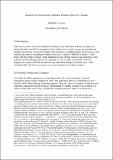Files in this item
Standards of cohesion and coherence : evidence from early readers
Item metadata
| dc.contributor.author | Lyons, Michael A. | |
| dc.date.accessioned | 2021-07-26T23:35:39Z | |
| dc.date.available | 2021-07-26T23:35:39Z | |
| dc.date.issued | 2020-07-27 | |
| dc.identifier | 266806404 | |
| dc.identifier | eda685f6-f1d8-4b71-9c64-9076b906fb67 | |
| dc.identifier | 000565684500004 | |
| dc.identifier.citation | Lyons , M A 2020 , ' Standards of cohesion and coherence : evidence from early readers ' , Hebrew Bible and Ancient Israel , vol. 9 , no. 2 , pp. 183-208 . https://doi.org/10.1628/hebai-2020-0011 | en |
| dc.identifier.issn | 2192-2276 | |
| dc.identifier.other | ORCID: /0000-0003-2940-3965/work/78528449 | |
| dc.identifier.uri | https://hdl.handle.net/10023/23642 | |
| dc.description.abstract | What can we know about the standards of cohesion and coherence held by the authors of ancient Israelite texts? If we recognize the fact that when we read we may be imposing our modern conventions on ancient literature, this becomes no small question. In this essay, I will consider the issue by examining evidence from early readers of biblical literature. I will begin with the earliest explicit reader statements about textual cohesion and coherence, then examine actual reading practices, moving back in time in order to determine whether responses to a perceived lack of cohesion and coherence change in various ways. I will conclude with reflections on what we can and cannot learn from this evidence. | |
| dc.format.extent | 26 | |
| dc.format.extent | 463521 | |
| dc.language.iso | eng | |
| dc.relation.ispartof | Hebrew Bible and Ancient Israel | en |
| dc.subject | BL Religion | en |
| dc.subject | T-NDAS | en |
| dc.subject | BDC | en |
| dc.subject | R2C | en |
| dc.subject.lcc | BL | en |
| dc.title | Standards of cohesion and coherence : evidence from early readers | en |
| dc.type | Journal article | en |
| dc.contributor.institution | University of St Andrews. School of Divinity | en |
| dc.identifier.doi | 10.1628/hebai-2020-0011 | |
| dc.description.status | Peer reviewed | en |
| dc.date.embargoedUntil | 2021-07-27 |
This item appears in the following Collection(s)
Items in the St Andrews Research Repository are protected by copyright, with all rights reserved, unless otherwise indicated.

